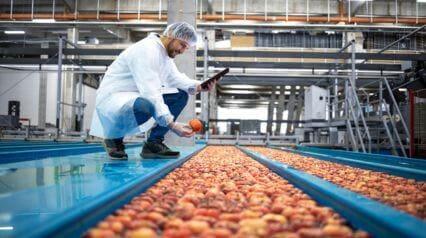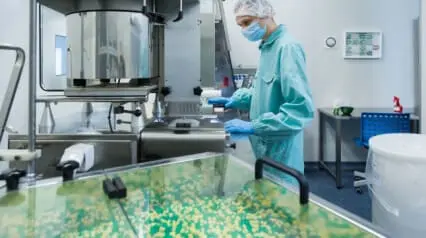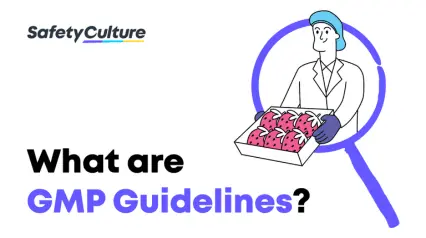What are Good Manufacturing Practices (GMPs) in the Food Industry?
Good Manufacturing Practices (GMPs) in the food industry are guidelines and principles implemented to ensure food safety and quality. GMPs cover all aspects of food production, from receiving raw materials to finished product shipment.
GMPs include guidelines on personnel hygiene, plant sanitation, equipment maintenance, product labeling, and record-keeping. These guidelines help prevent contamination, cross-contamination, and the introduction of foreign substances into the food supply.
Benefits
Compliance with GMP guidelines is essential for businesses involved in the food industry, and the benefits of adhering to these GMP regulations are numerous.
One of the most significant benefits of GMP compliance is that it helps to ensure that food products are safe for consumption. The guidelines cover everything from the cleanliness of the facility to the handling of ingredients and finished products. By following these guidelines, businesses can minimize the risk of contamination and ensure that their products are safe for consumption.
GMP compliance can also improve efficiency. By following standardized processes and procedures, businesses can streamline operations, reduce waste, and minimize errors, helping reduce costs and increase profitability.
Different GMPs in Food Manufacturing
Several GMPs are crucial to follow in the food industry. These practices ensure food is produced safely and hygienically and meets the necessary quality standards. Some of the most essential GMP requirements in food manufacturing include:
Quality Management
Quality management is essential to ensure the proper execution of the food manufacturing process. The process entails verifying that all food items meet the necessary quality criteria. The standards involve testing raw materials, monitoring production processes, and conducting final inspections.
Sanitation and Hygiene
Maintaining a hygienic environment throughout the food production facility is necessary to prevent contamination. Part of the protocol involves routine cleaning and disinfecting of surfaces, equipment, and utensils. Also, maintaining personal hygiene is crucial for food handlers to ensure safe food handling practices.
Improve your EHS Management
Cultivate a safe working environment and streamline compliance with our EHS solutions.
Explore nowPest Control
Pest control is necessary to ensure food safety and adhere to GMP standards. The process requires preventing pests such as rodents, insects, and birds in the food production area. Effective pest control includes the proper storage of food products to avoid infestation. It’s necessary for all surfaces that come in direct contact with food to be free of pests to prevent any contamination.
Suitable Facility Location
The ideal location for the facility should be free from contamination and pollution, and the facility should be designed for minimal risk in food manufacturing operations. It should also be easy and convenient for cleaning and maintenance.
Equipment
The design of the equipment used in food manufacturing should minimize potential errors and be appropriate for its intended use. All food-contact surfaces should be easy to clean and maintain.
Raw Materials
The quality of production materials must meet specific standards and be stored, handled, and utilized to prevent the risk of contamination of the final product. Suppliers and food ingredients must meet safety and quality specifications.
Product Labeling
All food products must have accurate and complete labeling containing relevant information. The required information comprises the product name, identity, net weight or measure, and the name and address of the food manufacturer or distributor. All food products must have a list of ingredients and any allergens present.
Storage and Transportation
Storing and transporting all food products under appropriate conditions is necessary for safety and quality. Food safety entails maintaining proper temperatures for food products (especially those that are considered Time and Temperature Control for Safety or TCS food), preventing contamination, and safeguarding against physical, chemical, and biological threats.
Personnel
Employees play a significant role in food safety. So, it’s necessary for all individuals who handle food to receive adequate training in food safety and good manufacturing practices. Individuals also need to be knowledgeable about potential hazards that may arise during food production.
Validation and Verification
It’s crucial to trace, verify, and validate all food safety procedures, which involve testing raw materials, monitoring production processes, conducting final inspections, and keeping records of all food safety activities. This process is essential to ensure the final product is safe for consumption.
Documentation and Record-Keeping
Proper documentation of food safety procedures is necessary. It includes recording raw materials, production processes, final inspections, and food safety activities. Documentation ensures compliance with safety procedures and enables prompt corrective action in case of any issues.
Inspection and Auditing
Government agencies require food manufacturing to undergo regular inspections. These inspections help ensure the facility complies with all food safety regulations. Additionally, third parties often audit certifications to verify compliance.
Create your own GMP Audit Checklist
Build from scratch or choose from our collection of free, ready-to-download, and customizable templates.
GMP Audit ChecklistsWhat are the 10 Principles of GMP?
These principles are essential for the food industry to follow to prevent contamination, maintain proper hygiene, and ensure that products meet regulatory requirements. Here are the ten key components:
Provide Detailed, Step-By-Step Instructions
The initial step of GMPs involves creating detailed, written SOPs. These serve as a guide for consistent performance and enable the establishment of workplace standards, ensuring that tasks are completed consistently.
Observe Established Procedures
The effectiveness of written SOPs depends on the individuals who follow them. Therefore, employees must be aware of the importance of strictly adhering to written instructions without making any modifications or taking shortcuts to achieve a consistent, high-quality outcome.
Document Everything
Adequate documentation is essential for regulatory compliance, issue tracking, prevention, and audits. Accurate record-keeping allows for evaluation and easy accessibility of necessary records.
Verify the Specifications and SOPs
Validation of processes, consistent documentation, and adherence to written procedures are necessary to ensure SOPs function properly and produce a reliable output.
Ensure the Quality and Safety of Equipment and Facilities
Building food manufacturing facilities and equipment must consider productivity, quality, and safety to maintain consistent quality.
Maintain Equipment and Facilities
It’s necessary to consistently perform maintenance on equipment and facilities and keep records to support the work done. It helps to minimize safety concerns and address quality control issues.
Demonstrate and Establish Job Competence
All team members must demonstrate job competency according to GMP guidelines. However, different people may define competency differently. Defining a role’s specific competencies will help avoid confusion.
Maintain a Clean Environment
It’s important to establish routine sanitization efforts for products to prevent the risk of contamination. Outline the steps for each zone in the facility and implement checks to ensure appropriate cleanliness levels based on product requirements.
Produce Quality Products
Implementing systematic quality control measures throughout production, including packaging, labeling, cooking, and handling, is crucial for maintaining consistent quality. Clearly defined controls and meticulous record-keeping are necessary to meet quality standards.
Implementing automation, including real-time statistical process control, can efficiently detect and resolve non-conformities through data collection and specification validation.
Perform Audits
Audits are an essential part of ensuring GMP effectiveness and regulatory compliance. While internal checks can be helpful, an external perspective can uncover overlooked inefficiencies or opportunities for improvement.




